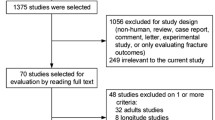Abstract
Objective
To investigate whether serum total alkaline phosphatase (ALP), bone-specific ALP (bone ALP), calcium, phosphorus, 25-hydroxyvitamin D (25-OHvit D) concentrations are altered early in the course of treatment with carbamazepine or valproic acid monotherapy in ambulatory children with adequate sun exposure; and to determine the effectiveness of simultaneous supplementation with calcium and 25-OHvit D at recommended dietary allowance doses on these biochemical parameters.
Methods
For each drug, children were divided into two groups (Group A: without supplementation; and Group B: with supplementation) and serum biochemical parameters estimated at 0, 30, 60, and 90 days of starting treatment. Statistical analysis: Serial changes in serum biochemical parameters (mean ± SD) were compared within each of the four groups using student’s paired t test. Also for each drug, serum biochemical parameters were compared between Groups A and B at 0, 30, 60, and 90 days of starting treatment using student’s unpaired t test.
Results
For both drugs, in Group A, serum total ALP levels were significantly increased above the normal range (P<0.0001) by 90 days of starting treatment; however, serum bone ALP level was significantly increased (P=0.002) only in children on valproic acid. For both drugs when serum biochemical parameters were compared between Groups A and B, supplementation resulted in a significant decrease in serum total ALP (P<0.0001) and bone ALP levels (P<0.001), and a significant increase in serum calcium (P<0.0001) and 25-OHvit D levels (P<0.0001) by 90 days of starting treatment.
Conclusion
Serum biochemical changes which indicate predisposition to development of rickets or osteomalacia appear within 90 days of starting carbamazepine or valproic acid monotherapy. However simultaneous supplementation with oral calcium and 25-OHvit D is effective in preventing the development of these adverse biochemical changes.
Similar content being viewed by others
References
Sheth RD, Wesolowski CA, Jacob JC et al. Effect of carbamazepine and valproate on bone mineral density. J Pediatr 1995;127:256–262.
Kafali G, Erselcan T, Tanzer F. Effect of antiepileptic drugs on bone mineral density in children between ages 6 and 12 years. Clin Pediatr (Phila) 1999;38:93–98.
Erbayat Altay E, Serdaroglu A, Tumer L, Gucuyener K, Hasanoglu A. Evaluation of bone mineral metabolism in children receiving carbamazepine and valproic acid. J Pediatr Endocrinol Metab 2000;13:933–939.
Rieger-Wettengl G, Tutlewski B, Stabrey A et al. Analysis of the musculoskeletal system in children and adolescents receiving anticonvulsant monotherapy with valproic acid or carbamazepine. Pediatrics 2001;108:E107.
Ecevit C, Aydogan A, Kavakli T, Altinoz S. Effect of carbamazepine and valproate on bone mineral density. Pediatr Neurol 2004;31:279–282.
Babayigit A, Dirik E, Bober E, Cakmakci H. Adverse effects of antiepileptic drugs on bone mineral density. Pediatr Neurol 2006;35:177–181.
Kumandas S, Koklu E, Gumus H et al. Effect of carbamezapine and valproic acid on bone mineral density, IGF-I and IGFBP-3. J Pediatr Endocrinol Metab 2006;19:529–534.
Pack AM. The association between antiepileptic drugs and bone disease. Epilepsy Curr 2003;3:91–95.
Collins N, Maher J, Cole M, Baker M, Callaghan N. A prospective study to evaluate the dose of vitamin D required to correct low 25-hydroxyvitamin D levels, calcium, and alkaline phosphatase in patients at risk of develo** antiepileptic drug-induced osteomalacia. Q J Med 1991;78:113–122.
Johnston CC Jr, Miller JZ, Slemenda CW et al. Calcium supplementation and increases in bone mineral density in children. N Engl J Med 1992;327:82–87.
Bonjour JP, Carrie AL, Ferrari S et al. Calcium-enriched foods and bone mass growth in prepubertal girls: a randomized, double-blind, placebo-controlled trial. J Clin Invest 1997;99:1287–1294.
Meyer-Sabellek W, Sinha P, Kottgen E. Alkaline phosphatase: Laboratory and clinical implications. J Chrom 1988;429:419–444.
Kruse K, Bartels H, Gunther H. Serum alkaline phosphatase isoenzymes in epileptic children receving anticonvulsant drugs. Eur J Pediatr 1977;126:237–242.
Watts NB: Clinical utility of biochemical markers of bone remodeling. Clin Chem 1999;45:1359–1368.
Looker AC, Bauer DC, Chesnut CH 3rd et al. Clinical use of biochemical markers of bone remodeling: current status and future directions. Osteoporos Int 2000;11:467–480.
Ross PD, Kress BC, Parson RE, Wasnich RD, Armour KA, Mizrahi IA. Serum bone alkaline phosphatase and calcaneus bone density predict fractures: a prospective study.Osteoporos Int 2000;11:76–82.
Kind PR, King EJ. Estimation of plasma phosphatase by determination of hydrolysed phenol with amino-antipyrine. J Clin Pathol 1954;7:322–326.
Moss DW, Whitby LG. A simplified heat-inactivation method for investigating alkaline phosphatase isoenzymes in serum. Clin Chim Acta 1975;61:63–71.
Kessler G, Wolfman M. An automated procedure for the simultaneous determination of calcium and phosphorus. Clin Chem 1964;10:686–703.
Fraser D, Jones G, Kooh SW, Radde IC. Calcium and phosphate metabolism. In Tietz NW, ed. Fundamentals of Clinical Chemistry, 3rd ed. Philadelphia; W B Saunders, 1987;705–728.
Aksnes L. A simplified high-performance liquid chromatographic method for determination of vitamin D3, 25-hydroxyvitamin D2 and 25-hydroxyvitamin D3 in human serum. Scand J Clin Lab Invest 1992;52:177–182.
Neill DW, Neely RA. The estimation of magnesium in serum using titan yellow. J Clin Pathol 1956;9:162–163.
Lubran MM. The measurement of total serum proteins by the Biuret method. Ann Clin Lab Sci 1978;8:106–110.
Doumas BT, Watson WA, Biggs HG. Albumin standards and the measurement of serum albumin with bromcresol green. Clin Chim Acta 1971;31:87–96.
Voudris KA, Attilakos A, Katsarou E et al. Early alteration in bone metabolism in epileptic children receiving carbamazepine monotherapy owing to the induction of hepatic drug-metabolizing enzymes. J Child Neurol 2005;20:513–516.
Tsukahara H, Kimura K, Todoroki Y et al. Bone mineral status in ambulatory pediatric patients on long-term antiepileptic drug therapy [published erratum appears in Pediatr Int 2002;44:466]. Pediatr Int 2002;44:247–253.
Sheth RD. Bone health in epilepsy. Epilepsia 2002;43:1453–1454.
Valmadrid C, Voorhees C, Litt B, Schneyer CR. Practice patterns of neurologists regarding bone and mineral effects of antiepileptic drug therapy. Arch Neurol 2001;58:1369–1374.
Author information
Authors and Affiliations
Corresponding author
Rights and permissions
About this article
Cite this article
Krishnamoorthy, G., Karande, S., Ahire, N. et al. Bone metabolism alteration on antiepileptic drug therapy. Indian J Pediatr 76, 377–383 (2009). https://doi.org/10.1007/s12098-009-0005-5
Received:
Accepted:
Published:
Issue Date:
DOI: https://doi.org/10.1007/s12098-009-0005-5




